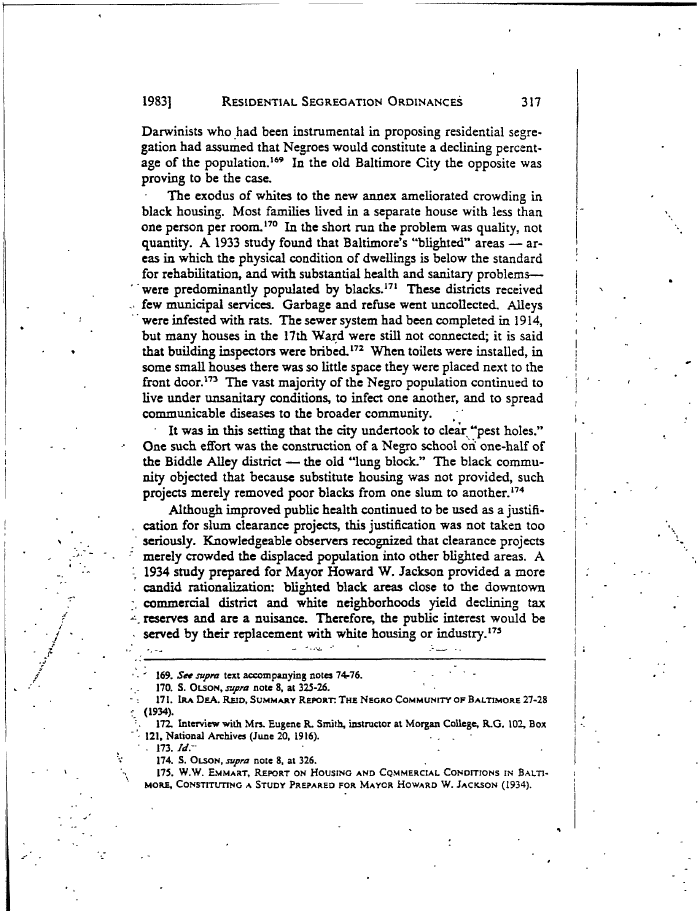 |
||||
|
Garrett Power, Apartheid Baltimore Style: The Residential Segregation Ordinances of 1910-1913, Maryland Law Review, 42 (1983) , Image No: 30 Enlarge and print image (64K) << PREVIOUS NEXT >> |
 |
||||
|
Garrett Power, Apartheid Baltimore Style: The Residential Segregation Ordinances of 1910-1913, Maryland Law Review, 42 (1983) , Image No: 30 Enlarge and print image (64K) << PREVIOUS NEXT >> |
| 1983] RESIDENTIAL SEGREGATION ORDINANCES 317 Darwinists who had been instrumental in proposing residential segre- gation had assumed that Negroes would constitute a declining percent- age of the population.169 In the old Baltimore City the opposite was proving to be the case. The exodus of whites to the new annex ameliorated crowding in black housing. Most families lived in a separate house with less than one person per room.170 In the short run the problem was quality, not quantity. A 1933 study found that Baltimore's "blighted" areas — ar- eas in which the physical condition of dwellings is below the standard for rehabilitation, and with substantial health and sanitary problems— were predominantly populated by blacks.171 These districts received few municipal services. Garbage and refuse went uncollected. Alleys were infested with rats. The sewer system had been completed in 1914, but many houses in the 17th Ward were still not connected; it is said that building inspectors were bribed.172 When toilets were installed, in some small houses there was so little space they were placed next to the front door.173 The vast majority of the Negro population continued to live under unsanitary conditions, to infect one another, and to spread communicable diseases to the broader community. It was in this setting that the city undertook to clear "pest holes." One such effort was the construction of a Negro school on one-half of the Biddle Alley district — the old "lung block." The black commu- nity objected that because substitute housing was not provided, such projects merely removed poor blacks from one slum to another.174 Although improved public health continued to be used as a justifi- cation for slum clearance projects, this justification was not taken too seriously. Knowledgeable observers recognized that clearance projects merely crowded the displaced population into other blighted areas. A 1934 study prepared for Mayor Howard W. Jackson provided a more candid rationalization: blighted black areas close to the downtown commercial district and white neighborhoods yield declining tax reserves and are a nuisance. Therefore, the public interest would be served by their replacement with white housing or industry.173 ' 169. See supra text accompanying notes 74-76. 170. S. OLSON, supra note 8, at 325-26. 171. IRA DEA. REID, SUMMARY REPORT THE NEGRO COMMUNITY OF BALTIMORE 27-28 (1934). 17Z Interview with Mrs. Eugene R. Smith, instructor at Morgan College. R.G. 102, Box 121, National Archives (June 20, 1916). ... 173. Id- 174. S. OLSON, supra note 8, at 326. 175. W.W. EMMART, REPORT ON HOUSING AND COMMERCIAL CONDITIONS IN BALTI- MORE, CONSTITUTING A STUDY PREPARED FOR MAYOR HOWARD W. JACKSON (1934). |